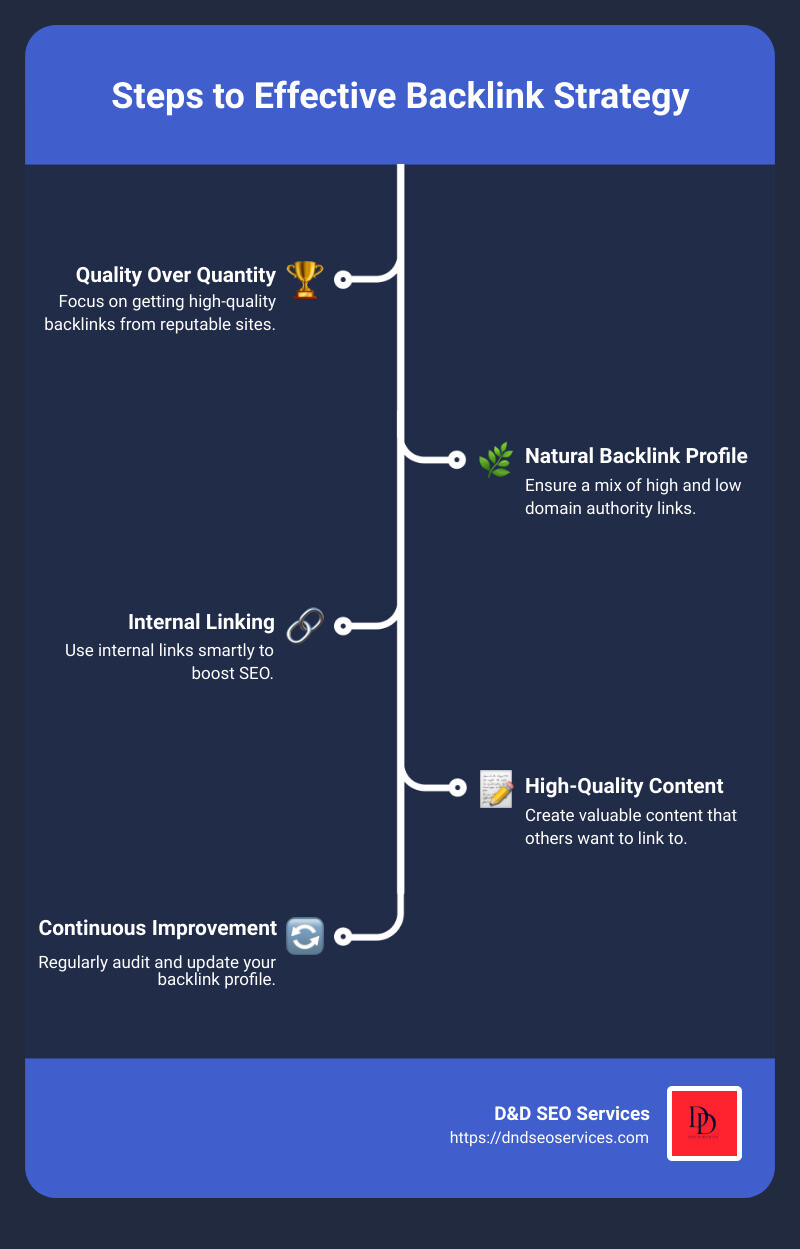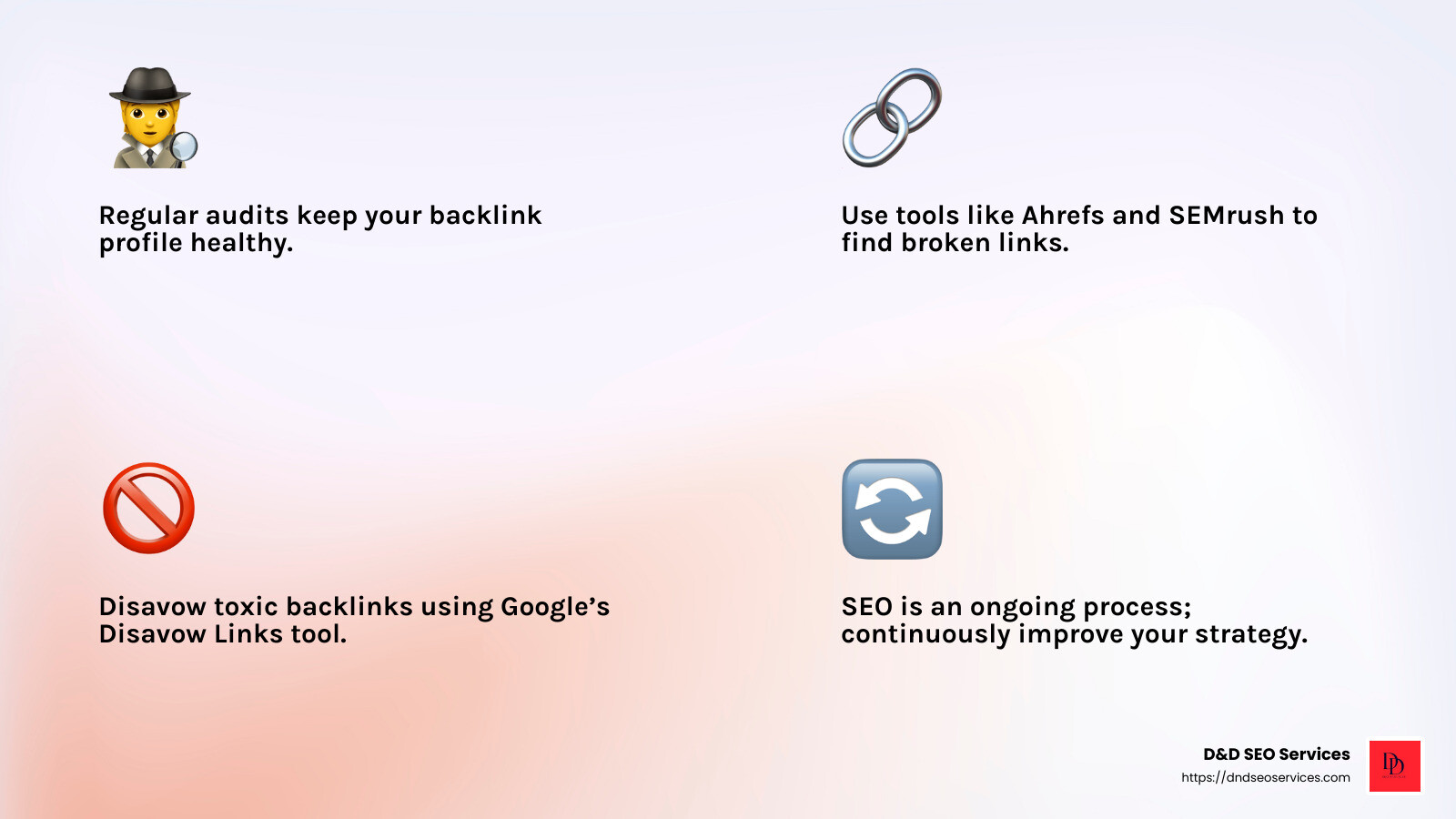The Importance of Backlinks in Your SEO Strategy
How Many Backlinks Do You Need For Effective SEO? The answer isn’t a one-size-fits-all number, but here’s a quick guide:
- 3-5 backlinks to each new, high-quality blog post.
- Focus on getting links from high-authority sites.
- Aim for a natural backlink profile—mix high and low domain authority links.
Backlinks play a pivotal role in your search engine ranking. Think of them as votes of confidence from other websites. When a reputable site links to yours, Google sees your content as valuable, which boosts your ranking. But it’s not about quantity; having a few high-quality backlinks is often more beneficial than having many low-quality ones.
In today’s competitive online landscape, your overall SEO strategy should focus on both the quality and placement of backlinks. Integrate keywords, use internal linking smartly, and ensure your content aligns with user intent to maximize your backlink strategy.
I’m Danielle Birriel, founder of D&D SEO Services. With over a decade of experience in SEO, I specialize in helping small businesses understand How Many Backlinks Do You Need For Effective SEO and implement strategies that work.
Simple guide to How Many Backlinks Do You Need For Effective SEO terms:
- Top 5 Reasons Your Business Isn’t Showing Up on Google Maps
- on page local seo
- why on page seo matters for local businesses
What Are Backlinks and Why Are They Important?
Backlinks are links from other websites that point to your site. They are also known as “inbound links” or “referral links.” These links act like votes of confidence for your content, signaling to search engines like Google that your website is credible and valuable.
Definition
A backlink is a hyperlink on one website that directs users to another website. For example, if a popular blog links to your site, you gain a backlink from that blog.
Referral Links
Referral links are a type of backlink that comes from external websites. When someone clicks on these links, they are referred to your site. This not only drives traffic but also signals to search engines that your site is worth visiting.
Authority
Backlinks help build your site’s authority. Google uses backlinks as a key ranking factor. The more high-quality backlinks you have, the more authoritative your site appears.
Domain Authority (DA) is a metric that indicates the strength of a website’s backlink profile. Websites with high DA scores can significantly boost your own site’s DA when they link to you.
Google Algorithms
Google’s algorithms are complex, but backlinks are one of the main ways they determine the relevance and authority of a site. When Google’s bots crawl the web, they look for backlinks to gauge the quality of your content.
Penguin Algorithm: Introduced in 2012, this algorithm targets sites with low-quality backlinks. It penalizes websites that use spammy link-building tactics.
PageRank: This is an older algorithm that still plays a role today. It measures the quality and quantity of backlinks to determine a page’s importance.
Key Takeaways
- Backlinks act as votes of confidence for your site.
- High-quality backlinks from authoritative sites carry more weight.
- Google algorithms use backlinks to rank your site in search results.
In the next section, we will explore How Many Backlinks Do You Need For Effective SEO and the factors that influence this number.
How Many Backlinks Do You Need For Effective SEO?
Determining the right number of backlinks for effective SEO can be tricky. It depends on several factors, including your website’s goals, niche, and competition.
Baseline Numbers
To be competitive for SEO, aim for:
- 40 to 50 backlinks to your homepage
- 0 to 100 backlinks to each individual web page
These are general guidelines. The actual number you need can vary based on other factors like domain authority and internal linking.
Factors Influencing the Number of Backlinks Needed
Domain Authority
Domain Authority (DA) is a metric that gauges the strength of your website’s backlink profile. Higher DA means your site is more authoritative. Websites with high DA can boost your rankings with fewer backlinks.
Internal Linking
Internal links help distribute authority across your website. According to SEO testing, three internal links are equivalent to one external backlink on average. Use keyword-rich anchor text for internal links to improve their effectiveness.
Keyword Difficulty
The difficulty of the keywords you’re targeting also affects the number of backlinks you need. For low-competition keywords, fewer backlinks might be enough. High-competition keywords will require more backlinks to rank well.
Niche Competition
Some niches are more competitive than others. If your niche is highly competitive, you’ll need more backlinks to stand out. Niche-specific backlinks can help you achieve better rankings with fewer links.
Quality vs. Quantity of Backlinks
High-Quality Links
Focus on earning high-quality backlinks rather than a large number of low-quality ones. Backlinks from authoritative sites carry more weight and can significantly boost your search rankings.
Toxic Backlinks
Avoid toxic backlinks from spammy or irrelevant sites. These can harm your SEO and even lead to penalties from Google. Regularly audit your backlink profile to identify and disavow toxic links.
Natural Backlink Profile
A natural backlink profile includes a mix of different types of backlinks, such as branded anchors, exact match anchors, and contextual links. This diversity signals to Google that your backlinks are earned naturally.
Key Takeaways
- Quality beats quantity: Focus on high-quality backlinks from authoritative sites.
- Domain authority and internal linking: These can reduce the number of backlinks you need.
- Keyword difficulty and niche competition: Tailor your backlink strategy to these factors.
- Natural backlink profile: Maintain a diverse and natural-looking backlink profile.
In the next section, we will explore Strategies to Build Effective Backlinks and how to implement them effectively.
Strategies to Build Effective Backlinks
Building backlinks is crucial for improving your website’s SEO. Here, we’ll discuss three key strategies: creating high-quality content, guest blogging and outreach, and fixing and utilizing broken links.
Creating High-Quality, Original Content
High-quality content is the cornerstone of effective backlink building. Google values quality over quantity, so focus on creating content that others will want to link to.
Blogging
Regularly updated blogs can attract backlinks naturally. Aim to publish posts once or twice a week, covering topics relevant to your audience. For example, a roofing company might blog about “5 Tips for Maintaining Your Roof in Winter.”
Infographics and Video Content
Visual content like infographics and videos can attract more backlinks than text alone. Infographics simplify complex information, making it easier to share. Videos, on the other hand, engage viewers and can be shared across multiple platforms.
Professional Photographs
High-quality images can improve your content and make it more shareable. For instance, a travel blog with stunning photographs is more likely to attract backlinks from other travel sites.
Guest Blogging and Outreach
Guest blogging is a powerful way to earn high-quality backlinks while reaching a new audience.
Relevant Websites
Identify blogs and websites in your industry that accept guest posts. Use tools like Ahrefs or Moz to find sites with high Domain Authority (DA).
Personalized Emails
When reaching out to website owners, personalize your emails. Mention specific articles you enjoyed on their site and explain why your guest post would be valuable to their audience.
Follow-Up
Don’t be discouraged if you don’t get a response right away. Follow up politely after a week or two to remind them of your proposal.
Fixing and Utilizing Broken Links
Broken link building involves finding broken links on other websites and suggesting your content as a replacement.
Broken Link Checker Tools
Use tools like Ahrefs or SEMrush to find broken links on high-authority sites. These tools can identify links that return a 404 error, indicating a broken link.
Outreach for Broken Links
Once you’ve identified broken links, reach out to the site owners. Politely inform them of the broken link and suggest your relevant content as a replacement.
Replacing Broken Links
Ensure that the content you offer as a replacement is high-quality and relevant to the original link. This increases the chances that the site owner will use your link.
Key Takeaways
- Create high-quality, shareable content: Use blogs, infographics, videos, and professional photographs.
- Guest blog on relevant websites: Personalize your outreach emails and follow up.
- Fix broken links: Use tools to find broken links and suggest your content as a replacement.
In the next section, we will explore how to Monitor and Maintain Your Backlink Profile to ensure long-term SEO success.
How to Monitor and Maintain Your Backlink Profile
Monitoring and maintaining your backlink profile is essential for sustained SEO success. This section will guide you through the use of SEO tools for backlink analysis and the importance of regular audits and maintenance.
Using SEO Tools for Backlink Analysis
SEO tools are invaluable for tracking and analyzing your backlinks. They help you identify high-quality links, spot toxic backlinks, and understand your overall backlink profile.
Ahrefs
Ahrefs is a comprehensive tool that provides detailed insights into your backlink profile. It shows you all the backlinks pointing to your site, their quality, and the anchor text used. Ahrefs also helps you identify new backlinks and spot any harmful links that might need disavowing.
Moz
Moz offers robust backlink analysis features through its Link Explorer tool. It provides metrics like Domain Authority (DA) and Page Authority (PA), helping you evaluate the quality of your backlinks. Moz also offers tools for tracking your link-building progress and identifying potential opportunities.
Google Search Console
Google Search Console is a free tool that lets you monitor your website’s performance in Google search results. It provides a comprehensive list of backlinks to your site and alerts you to any manual actions or penalties. This tool is essential for maintaining a healthy backlink profile.
Other Backlink Checker Tools
Tools like SEMrush and Screaming Frog SEO Spider offer additional functionalities for backlink analysis. SEMrush provides in-depth reports on your backlink profile, while Screaming Frog helps you identify broken links and other technical SEO issues.
Regular Audits and Maintenance
Regular audits are crucial for keeping your backlink profile clean and effective. Here’s how to approach it:
Audit Frequency
Perform backlink audits at least once per quarter. For high-traffic or e-commerce sites, monthly audits are ideal. Regular audits help you stay on top of any changes and ensure your backlink profile remains healthy.
Fixing Broken Links
Broken links can harm your SEO efforts. Use tools like Ahrefs and SEMrush to identify broken links on your site. Reach out to the site owners and suggest your content as a replacement for any broken external links pointing to your site.
Disavow Toxic Links
Toxic backlinks can negatively impact your SEO. If you find harmful links that you can’t remove manually, use Google’s Disavow Links tool. Create a list of toxic links and upload it to the tool to ensure Google ignores these links when assessing your site.
Continuous Improvement
SEO is an ongoing process. Continuously monitor your backlink profile and look for opportunities to acquire high-quality links. Update your content regularly to keep it relevant and shareable, which naturally attracts more backlinks.
By using these tools and strategies, you can effectively monitor and maintain your backlink profile, ensuring long-term SEO success.
In the next section, we will address Frequently Asked Questions about Backlinks to clear up any lingering doubts you might have.
Frequently Asked Questions about Backlinks
How Many Backlinks Should I Build Per Month?
Building backlinks is crucial for SEO, but how many should you aim for each month? A general rule of thumb is to build 5-10 backlinks per 2,000 words of content. This helps maintain a natural link profile and avoids raising red flags with search engines.
Anchor Text Strategy is also essential. Use a mix of natural anchors, blended anchors, and exact match anchors. For example, if your key phrase is “socks,” a blended anchor might be “a good selection of cotton socks.” This diversity makes your backlink profile look more organic.
Can Too Many Backlinks Hurt My SEO?
Yes, too many backlinks can hurt your SEO if they appear unnatural. Google penalizes sites with unnatural link patterns and toxic backlinks.
Unnatural Link Patterns: These occur when too many backlinks are built too quickly or if there is an overuse of exact match anchor text. Google expects less than 10% of backlinks in a top-ranked profile to be exact match anchors.
Toxic Backlinks: These come from low-quality or spammy sites. They can decrease your page rank and, in severe cases, lead to manual penalties from Google. Use tools like Ahrefs or Moz to identify and disavow these harmful links.
How Do I Know If My Backlinks Are Effective?
To determine if your backlinks are effective, monitor the following metrics:
-
Traffic Analysis: Check if your site traffic increases after acquiring new backlinks. Tools like Google Analytics can help you track this.
-
Ranking Improvements: Use SEO tools to monitor changes in your search engine rankings. A rise in rankings for targeted keywords often indicates effective backlinks.
-
Domain Authority (DA): High-quality backlinks can improve your site’s DA, a metric that predicts your ability to rank on search engines. Tools like Moz provide insights into your DA and how it changes over time.
By focusing on these metrics, you can gauge the effectiveness of your backlink strategy and make necessary adjustments for sustained SEO success.
In the next section, we will explore Strategies to Build Effective Backlinks, including creating high-quality content, guest blogging, and fixing broken links.
Conclusion
In summary, determining How Many Backlinks You Need For Effective SEO involves understanding various factors such as domain authority, keyword difficulty, and niche competition. The key takeaway is that quality always trumps quantity. High-quality backlinks from authoritative sites will boost your rankings more effectively than a large number of low-quality links.
SEO is not a one-time task. It requires continuous effort. Regularly auditing your backlink profile, updating content, and disavowing toxic links are essential practices for maintaining and improving your rankings.
At D&D SEO Services, we understand that every business is unique. That’s why we offer personalized strategies custom to your specific needs. Whether you need help with local SEO or comprehensive on-page SEO services, we’re here to assist you.
Building a strong backlink profile is just one part of a successful SEO strategy. By combining great brand trust, creating content that outperforms competitors, and securing high-quality backlinks, you can achieve and maintain top rankings on Google.
Ready to improve your search engine rankings and attract more local customers? Contact D\&D SEO Services today to get started on your journey to online success!
By integrating these strategies, you’ll create a stronger digital narrative that resonates with your audience, fostering growth and sustained customer relationships.









